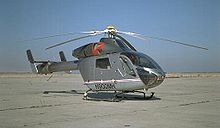McDonnell Douglas NOTARY
NOTAR ( No Ta il R otor ; German no tail rotor ) is a system from McDonnell Douglas for torque compensation in helicopters without the typical tail rotor configuration . The patent is owned by Boeing .
development
The test vehicle was a Hughes OH-6 , in which the tail boom had been reinforced and a ducted propeller blew air into the boom. This flowed out through a longitudinal slot on the right underside of the boom. An adjustable nozzle was attached to the stern to control the thrust . The first flight of this system took place on December 17, 1981.
Similar systems, in which mostly the exhaust gas flow of the engine was used, were already tested in the 1940s with the Cierva W.9 , the Hiller J-5 or in the 1950s with the Aerotecnica AC-12 Norelle .
Working principle

In principle, in a helicopter with only one main rotor, the torque generated by it must be compensated in order to counteract a rotation of the fuselage and to be able to control the helicopter around the vertical axis ( yaw axis ), which is usually achieved by the horizontally acting tail rotor .
The NOTAR system generates the counterforce on the one hand with outlet nozzles placed along the tail boom and on the other hand with a directed air jet that exits through a variable control nozzle at the end of the boom. Along the entire length of the tail boom, the air exits through two 0.85 cm wide slots on the right-hand side with an overpressure of 0.034 bar. At the far end of the boom there are a number of outlet slots, the air flow of which can be controlled by the rotating cover. The air inlet (1) is behind the main rotor, after which a fan (2) pushes the air into the tail boom.
The air flowing out at the outlet nozzles (3) guides the downdraft (6) flowing down from the main rotor around the curve of the boom. The Coandă effect is used , the flow around a cylindrical pipe with a one-sided slot-shaped blowout tangential to the pipe surface. In superimposition with the flow around it, this creates a circulation with pressure and suction side. This creates a force counteracting the main rotor torque (8), which stabilizes the fuselage in the longitudinal direction. Since the propeller at the beginning of the tail boom can be adjusted using the foot pedals in the cockpit, the amount of air blown into the tail boom can be adjusted, thus influencing the strength of the Coandă effect (and thus the rotation around its own axis). This achieves approximately 2/3 of the desired torque compensation.
This effect is intensified by the remaining air that is not already "used" by the boom slots, which exits at the end of the tail boom (5) and the remaining third of the torque compensation is ensured by the exhaust control. Since the rotation of this nozzle is coupled with the foot pedals in the cockpit, the course or the rotation around your own axis can be precisely controlled.
The advantages of the NOTAR system are the lower risk potential for people in the take-off and landing zone and the lower level of noise, since the propeller is inside and there is no noisy interaction between the main and tail rotor.
Models with NOTAR technology
- MD 520N
- MD 600N
- MD Explorer (MD 900)
See also
literature
- Robert F. Dorr: Explorer-NOTAR comes of age . In: AIR International December 1994, pp. 350–355
- Rolf Besser: Technology and History of the Helicopter. From Leonardo da Vinci to the present. 3. Edition. Bernard and Graefe, Bonn 1996, ISBN 3-7637-5965-4 .
Web links
- Video explaining how the NOTAR works (accessed on August 13, 2018)
- Army helicopters McDonnell Douglas MD 520N and 530N (serial NOTAR helicopter; private website)
Individual evidence
- ↑ McDonnell Douglas merged with Boeing New perspectives for the giant Boeing. In: www.nzz.ch . Neue Zürcher Zeitung, May 28, 2001, accessed on November 2, 2018 .
- ↑ Andreas Middel: Brussels approves Boeing merger. In: www.welt.de . Axel Springer SE, July 24, 1997, accessed on November 3, 2018 .

